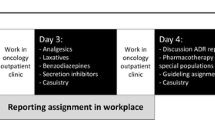Abstract
In a prospective, crossover study, we assessed the impact of a clinical pharmacist on identification and reporting of adverse drug events (ADEs) in hospitalized patients. The study was conducted on four units of a medical ward of a university hospital, with two units serving as test, the other two as control units. After 12 months, test and control units were switched. In the test units, a pharmacist participated in daily ward rounds, solicited additional information from physicians and nurses, and reviewed the charts of all patients. In control units, information on ADEs was based solely on voluntary reports from physicians and nurses. A total of 1959 patients (941 in test, 1018 in control units) were hospitalized during the study period. In 137 test units patients, 224 ADEs (14.6%; 95%‐CI: 12.3%‐16.9%) were detected (8 severe, 60 moderate, 156 mild), while 25 ADEs (1 severe, 11 moderate, 13 mild) occurring in 21 patients (2.1%; 95%‐CI: 1.2%‐3.0%) were reported from the control units (p<0.0001). Of the ADEs in the test units, 51% were reported spontaneously, 39% were identified on rounds, and 10% by chart review. After changing the status of test and control units, the number of identified ADEs returned to preintervention levels. Clinical pharmacists as part of the medical care team can improve the identification of ADEs which may ultimately translate into improved quality of care.
Similar content being viewed by others
References
Karch FE, Lasagna L. Adverse drug reactions. A critical review. JAMA 1975;234:1236-41.
Lazarou J, Pomeranz BH, Corey PN. Incidence of adverse drug reactions in hospitalized patients. A meta-analysis of prospective studies. JAMA 1998;279:1200-5.
Classen DC, Pestotnik SL, Evans RS, Lloyd JF, Burke JP. Adverse drug events in hospitalized patients. Excess length of stay, extra costs, and attributable mortality. JAMA 1997;277:301-6.
Chatas CA, Vinson BE. Program for improvig adverse drug reaction reporting. Am J Hosp Pharm 1990;47:155-57.
Irvin LE, Grimmer SFM, Smith JC. Adverse drug reaction reporting. Br J Pharm Pract 1987;9:316-21.
Jacinto MS, Kleinman K. Hospital pharmacy program for reporting adverse drug reactions. Am J Hosp Pharm 1983;40:444-45.
Miwa LJ, Randall RJ. Adverse drug reaction program using pharmacist and nurse monitors. Hosp Pharm 1986;21:1140-46.
Winstanley PA, Irvin LE, Smith JC, Orme MLE, Breckenridge AM. Adverse drug reactions; A hospital pharmacy-based reporting scheme. Br J Clin Pharmacol 1989;28:113-16.
Bergman HD, Aoki VS, Black HJ, Leaverton PE, Dick RW, Wilson WR. A new role for the pharmacist in the detection and evaluation of adverse drug reactions. Am J Hosp Pharm 1971;28:343-50.
Keith MR, Bellanger-McCleery RA, Fuchs JE. Multidisciplinary program for detecting and evaluating adverse drug reactions. Am J Hosp Pharm 1989;46:1809-12.
Prosser TR, Kamysz PL. Multidisciplinary adverse drug reaction surveillance program. Am J Hosp Pharm 1990;47:1334-39.
Gardner P, Watson LJ. A pharmacist-based monitoring system. Clin Pharmacol Ther 1970;11:802-7.
Powell SH, Schwartz PA, Rayment CM, Marx CM. Pharmacy-based adverse drug reaction surveillance program. Am J Hosp Pharm 1982;39:1963-64.
Kilarski DJ, Ziegler B, Coarse J, Buchanan C. Adverse drug reaction reporting system: Developing a well-monitored program. Hosp Formul 1986;21:949-52.
Berry LL, Segal R, Sherrin TP, Fudge KA. Sensitivity and specificity of three methods of detecting adverse drug reactions. Am J Hosp Pharm 1988;45:1534-39.
Gilroy GW, Scollins MJ, Gay CG, Harry DJ, Giannuzzi DF. Pharmacy-coordinated program that encourages physician reporting of adverse drug reactions. Am J Hosp Pharm 1990;47:1327-33.
Kimelblatt BJ, Young SH, Heywood PM, Mandala AR, Gendelman S, Mehl B. Improved reporting of adverse drug reactions. Am J Hosp Pharm 1988;45:1086-89.
Koch KE. Use of standardized screening procedures to identify adverse drug reactions. Am J Hosp Pharm 1990;47:1314-20.
Bennett BS, Lipman AG. Comparative study of prospective surveillance and voluntary reporting in determining the incidence of adverse drug reactions. Am J Hosp Pharm 1977;34:931-36.
Schumock GT, Thornton JP, Witte KW. Comparison of pharmacy-based concurrent surveillance and medical record retrospective reporting of adverse drug reaction reporting. Am J Hosp Pharm 1991;48:1974-76.
McKenney JM, Wasserman AJ. Effect of advanced pharmaceutical services on the incidence of adverse drug reactions. Am J Hosp Pharm 1979;36:1691-97.
Hardman C, Lloyd B. Adverse drug reaction monitoring by ward pharmacists. J Clin Hosp Pharm 1982;7:71-73.
World Health Organization. International drug monitoring. Tech Rep Ser 1969;426:5-24.
Rawlins MD. Adverse reactions to drugs. Br Med J 1981;282:974-76.
deShazo RD, Kemp SF. Allergic reactions to drugs and biologic agents. JAMA 1997;278:1895-1906.
Gardner MJ, Altman DG. Statistics with confidence. London, England: British Medical Journal, 1989.
Bates DW, Spell N, Cullen J, et al. The costs of adverse drug events in hospitalized patients. JAMA 1997;277:307-11.
Leape LL, Bates DW, Cullen DJ, et al. System analysis of adverse drug events. ADE Prevention Study Group. JAMA 1995;274:35-43.
Case RL, Guzzetti PJ. A survey of adverse drug reaction reporting programs in select hospitals. Hosp Pharm 1986;21:423-33.
Classen DC, Pestotnik SL, Evans RS, Burke JP. Computerized surveillance of adverse drug events in hospitalized patients. JAMA 1991;266:2847-51.
Schlienger RG, Lüscher TF, Haefeli WE. Clinical pharmacists' effect on drug information requests [letter]. Ann Pharmacother 1996;30:85.
Bates DW, Cullen DJ, Laird N, et al. Incidence of adverse drug events and potential adverse drug events. Implications for prevention. ADE prevention group. JAMA 1995;274:29-34.
Klein U, Gikalov I, Keller M, Hoigné R. “Drug-monitoring” in der Medizinischen Abteilung eines Regionalspitals. Schweiz Med Wschr 1972;102:1083-90.
Green DM. Pre-existing conditions, placebo reactions, and “side-effects”. Ann Intern Med 1964;60:255-65.
Meyer FP, Tröger U, Röhl F-W. Adverse nondrug reactions: An update. Clin Pharmacol Ther 1996;60:347-52.
Johnson JM. Contributing to drug safety [editorial]. Am J Hosp Pharm 1990;47:1280.
Kennedy DL, Johnson JM, Nightingale SL. Monitoring of adverse drug events in hospitals. JAMA 1991;266:2878.
Rights and permissions
About this article
Cite this article
Schlienger, R.G., Lüscher, T.F., Haefeli, W.E. et al. Academic detailing improves identification and reporting of adverse drug events. Pharm World Sci 21, 110–115 (1999). https://doi.org/10.1023/A:1008631926100
Issue Date:
DOI: https://doi.org/10.1023/A:1008631926100




